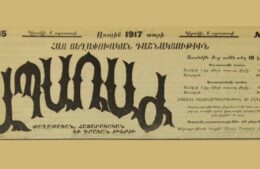Avedis’ Story: An Armenian Boy’s Journey
- (0)
Avedis’ Story: An Armenian Boy’s Journey –

By Kubra Uygur*
Abrahamian, A Avedis (2014) AVEDIS’ STORY: An Armenian Boy’s Journey (ed. C. S. Najarian), Gomidas Institute, London ISBN 978-1-909382-13-8, paperback, Price: UK£16.00 / US$22.00.
Armenians in the Kharpert Plain cir. 1915, a full color foldout map (Gomidas Institute, 2015) Price: UK£8.00 / US$12.00.
Special Offer for April 2015. Order the book and map from books@gomidas.org for $30.00, including free shipping and handling.
Avedis’s Story is about the journey of a nine year old Armenian boy that starts in Ottoman Turkey and ends in the United States. Avedis dictates his memoirs into a tape recorder when he is 65 years old and his daughter transcribes and edits them to write her father’s memoirs. The story consists of three parts: his life in the village, the period of the Armenian genocide and its aftermath, and life in America.
Life in the small village
Avedis was born in 1906 in a small village, Sheykh Hadji in Mamouret ul-Aziz (today known as Elazig), one of the six so-called Armenian provinces of the Ottoman Empire. During these early years his father was living in the United States, like many other Armenian men in those days, to work and save money to bring back to his village for a better life. Avedis describes a very colorful and joyful village life, which had lots of festivals (not only the Christian ones but also the Pre-Christian pagan festivals), his close relations with relatives and friends. He portrayed cooperation among the village people who worked together, shared food, and helped the poor to eliminate poverty.
However, although the picture he paints seems to be very peaceful in general, he mentions the segregation and disparity of communities as well. From the very beginning of the book it is understood that there were two communities in those provinces, Turkish and Armenian, and people of these two groups lived in separate quarters. He also gives reader a hint of the oppression on the Armenian community by the ‘Beg’ – a title for the chieftain who governed the province – in terms of the unfair tax collection from the Armenians.
The genocide and the endless journey to survive
In Sheykh Hadji, and many other Armenian inhabited villages, rumors spread of a planned Armenian deportation. The year was 1914 and the Ottoman Empire was about to enter World War I. Since the memoir was recorded years after the genocide, Avedis added his own observation to the period, describing the situation in the empire. He explained that the Balkans had gained their freedom, as did the Albanians, Greeks, and Romanians. As the Armenians became more educated and literate, their horizons widened and they began to question their situation under the Turks. They also started to dream about their freedom. Avedis comments that except Germany, which was the ally of the Ottomans, other countries like Great Britain, France, and the United States were promising Armenians a better life from the Ottoman Sultan. Avedis’s describes the changing conditions within the Empire and the influence of the new dynamics.
Turkish officers came to Avedis’s village and beat the elder Armenian men in the village square and collected guns the Armenians had in their houses. A couple of weeks later, soldiers surrounded the village with heavy arms and gathered all men above the age of 14 to take outside of the village to be shot. Avedis’s two great uncles managed to hide from the soldiers at first, but also disappeared later on. As the soldiers searched the houses, they collected all women and children, preventing them from taking any of their belongings, before deporting them to an unknown destination. During the deportation, some of the Armenian women were forced to marry rich Turkish men and some resisted and committed suicide.
With the situation worsening in Sheykh Hadji, Avedis’s mother decided to leave the village and go to her siblings in Elazig. They hid in a German orphanage for some time but, unfortunately this place also became unsafe and they had to move. In 1916 Avedis travelled northeast, across the Dersin, to areas under Russian occupation. There, in towns such as Erzingan, Erzurum and Trebizon [Trabzon], smugglers who took Armenians to the Russian side. Avedis walked to Trebizon and stayed there for a couple of months.
Avedis mentioned a name, Soghomon Tehlirian, who owned a shop in Trebizon. He worked for Tehlirian and later highlighted this name since Tehlirian would later become a national hero for assassinating Talat Pasha in Berlin. However, the editor added a footnote and argues that Tehlirian reportedly lived in Tiflis after his escape from the Ottoman Empire during the World War I and his stay in Trebizon could not be confirmed.
Another journey started after Trebizon became unsafe. This time Avedis and family members travelled to Batum, which was considered safer, also under Russian control. From Batum they continued to Tiflis where many Armenian refugees lived. In Tiflis, Avedis, along with his brother and sister, attended a Mekhitarian school. The head teacher wanted to keep Avedis and his sister there. However, Avedis’s mother did not agree, as she wanted to go to her husband in America. However, it was not easy to go to America, because the route was becoming more dangerous each day. She decided to travel into Russia and they walked to Armavir, a northern Caucasus city in Russia. They remained there for two years, until the fighting between the Bolsheviks and the Red Army created chaos in the city. They left and headed to Stavropol.
Here, Avedis criticizes Russia for changing its policies and leaving Armenians alone to defend themselves. The Imperial Russian Army was supposed to protect the Armenians, but instead they abandoned them against the invading Turks. Thus, Avedis reflected that Armenians were not only disappointed with the Turks, but also with the Russians.
Avedis and his family’s endless struggle to survive continued when they reached Constantinople in 1920. After a year’s stay, they approached a relief organization, Near East Relief, to help them in arranging their trip to America. They received passports in 1921 and travelled to America to unite with their father.
Life in the New World: America
After a horrific journey, which took six years, Avedis and his family reached America where Avedis’s father met them. Avedis describes the home in which they live in New York. Although it was not an easy start in terms of adapting to this new country, learning a new language and the difficulties at school, he never complains about them. Besides, their father, Avedis and his brother started work and they began their own business. They bought a house for themselves and met other Armenians from their hometown. Avedis ends his memoir in a cheerful tone but it is inevitable to hear his touching words “The past was buried but could never be forgotten.”
Observations
“Avedis’s Story” is not a diary, written during or just after the genocide. Avedis recorded his memories when he was 65, and this enabled him to add the knowledge he gained through his readings afterwards and provided some historical background context. Therefore, the book is not only portraying the horrific story of an Armenian boy, but also the political conflicts and encounters of the period. Although memoirs are generally subjective, in Avedis’s case, it is possible to see the bigger picture with objective arguments. As the editor remarks in the introduction, Avedis, throughout his life, thought about the events he and his family had experienced. He studied history by himself to understand why Armenians in the Ottoman Empire suffered and he investigated the reasons for it by considering some other historical cases such as those involving native Americans, African Americans or European Jews.
Avedis’ s observations combined with his memories are invaluable for historians, because he explains his life experiences by also providing a historical background. The reader learns about ordinary village life of Armenians under the Ottoman Empire, with the contrast of peace and discrimination; it discusses the impact of World War I on the cities Avedis had to traverse. Furthermore, the book holds lessons for future policy makers dealing with Turks-Armenian relations. For example, Avedis describes how he beat two innocent Turkish boys to take revenge on Turks for his own misfortunes, and he expresses his own regret for his actions. He concludes his self-criticism by reflecting, “Armenians must ask for justice for the misdeeds of the past, not take revenge.”
• Kubra Uygur is a PhD student in Ottoman & Byzantine and Modern Greek Studies (University of Birmingham)


















